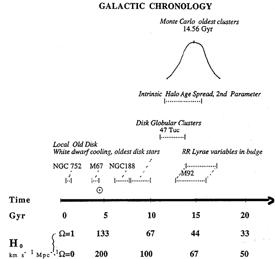


A summary of the chronology of the Galaxy is shown in Figure 10. The best determined age is that of the Sun, near 4.5 Gyr, which is derived by combining the radioactive age of the solar system with our knowledge of pre-main sequence evolutionary timescales (Guenther 1989). Interior models of the Sun can now be tested using helioseismology. The best data available from the Birmingham BiSON network yield low-l p-mode frequencies and second order differences which are consistent with the radioactive age the Sun within five percent (Chaplin et al. 1996; Guenther et al. 1996). Data being accumulated with the ground-based GONG network and the SOHO satellite will further refine this test in the near future.
Open star clusters in the Galactic disk which have chemical compositions similar to that of the Sun and also similar ages can also be dated using recent CMD's, with better photometry and CMD's cleaned up for membership (Dinescu et al. 1995). Two of these open clusters, M67 and NGC188, are also shown in Figure 10. There are indications that some open clusters, and a fraction of the disk field population may be as old as 10 Gyr. The age of the old disk stars has also been estimated from radioactive isotope abundances in their spectra to be in the vicinity of 10 Gyr, although the result depends on the adopted model of Galactic nucleosynthesis. Finally, the cooling of white dwarfs yield age estimates for the oldest Galactic disk population of the order of 10 Gyr (D'Antona & Mazzitelli 1990).

|
Figure 10. Summary of "best" galactic chronology. |
The age distribution of the oldest globular clusters derived from the
Monte Carlo
study discussed in Section 5 of this paper
is also shown. Note that in addition to the
age uncertainty due to the parameter uncertainties included in the Monte
Carlo analysis,
there is also evidence for a real age spread among the halo globular
clusters. Although
the magnitude of this age spread has been debated, it is generally
believed that relative
ages (from HB morphology and turnoff luminosity taken together) are
better determined
for clusters of the same metallicity than their absolute ages
(Sarajedini & King
1989;
Lee et al. 1990,
1994).
The scale also gives the values of H0 that is
compatible with each age
on the age axis, assuming the two extreme values of the cosmological
density parameter
 = 0 and
= 0 and
 = 1.
= 1.
The question still does arise: how difficult would it be to decrease the globular cluster ages to 10 Gyr? The Monte Carlo analysis was designed to answer this question, and within the limits of its validity, the answer is that it is very unlikely. Some reasonable estimate of the errors in the observational data, in particular the distance and chemical composition parameters, can be made. On the theoretical side, it is also possible to take into account the sensitivity on the evolutionary tracks due to the input physics with some reliability. It is naturally impossible to evaluate the possible effects of unknown or erroneously modeled physics. However, in the case of the Sun, it is possible to make an estimate of the reliability of ages based on standard stellar evolution theory and pulsation theory: using the latest physics, the "best" seismic age for the Sun is 5% larger than the radioactive solar age derived from the meteorites.
Still, in the case of globular cluster stars, could the theoretical calibration be in error, beyond the estimates used in a Monte Carlo study, and beyond the error in the solar age? In the final analysis, the issue is whether the theoretical turnoff luminosity in the CMD could be fainter, for a given age, that is now calculated. If this is the case, it would be detectable in the luminosity function near the turnoff. Globular cluster observations with the HST should provide the crucial test, since it is now possible to observe CMD's and luminosity functions with the required precision to verify our ability to model the rate of evolution, not only in luminosity, but also in color, of turnoff stars in globular clusters.
In order to reduce the error bars in the globular cluster age determinations, the full resources of the HST, and of the most powerful ground-based telescopes, such as the Keck telescopes and the 8-meter class telescopes now under construction, will be required to continue the work on the distances and the chemical abundances of main sequence and subgiants stars in globular clusters, the two major uncertainties in globular cluster ages.
As indicated by our Monte Carlo study, the third significant source of age uncertainty lies in the modeling of the convective layers which determine the model radii. New theoretical efforts should be aimed at the calculation of reliable stellar radii and of the rate of change of stellar radii as stars evolve from the main sequence to the subgiant and giant branch. And observations should involve, in addition to high precision luminosity functions, high precision color functions (or envelope entropy functions, as they measure the evolution of specific entropy in the convective envelope). The theoretical derivation of envelope entropy functions will require continued improvements in the numerical simulation of radiative-convective stellar photospheres and subphotospheres, an active topic of research at this time (Kim et al. 1995, 1996; Ludwig et al. 1996). We can expect rapid progress in this area due to the convergence of two new developments: (1) the ability to perform increasingly more realistic 3D numerical simulations of radiative hydrodynamics in the solar envelope; (2) the coming of age of helioseismology which now permits the detailed probing of the solar subphotospheric layers and to test directly the structure of the superadiabatic layer. As of this writing, there are also hopeful signs that the techniques of convection modeling and of seismology can soon be extended to test the subphotospheric layers and convection zone depth of other nearby sun-like stars as well.